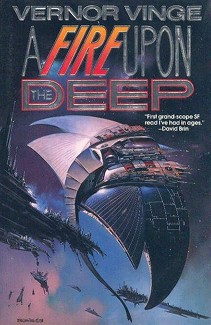I had intended to cover my reading on this blog as well as
games, but not really gotten around to it despite reading a fair amount. So I
am going to have a quick run through a few items in this post;
The Dispossessed: Ursula K. Le Guin (1974) – This is great,
one of the best SF novels I have read and surprisingly so. I had read some of
her young adult fantasy a few years back, The Wizard of Earthsea and its
followers. The Dispossessed is very different beast, an allegorical story
exploring leaving a hippy collectivist commune to engage with the capitalist –
communist split world. Being a Sci-Fi novel the commune is colony scraping by
on a desolate moon and the imperial world the eden below. A physicist, Shevek,
betrays his own anarchist people to return to the mother planet on a quest to
heal what divides them. Of course reconciliation is harder than anticipated due
to the differing world views and entrenched prejudice. Le Guins' skill is in
her character building and the slow stripping away of Sheveks' idealism as he
faces the reality of the world he lives in. He comes to see the short comings
of his home culture and the old alien one. A top 10 Sci Fi novel.
Dying Inside: Robert Silverberg (1972) – Robert Silverberg
is a very talented writer, that much is obvious reading this. It has addictive
prose and moves at a pace. That said I hated this novel once I got past around
50 pages. The novel explores what would really happen if someone could read
minds, would they do good? Or would they would use it for sexual voyeurism? The
latter of course. The protagonist is a depressing aging man living in the 1970s
born with a now decaying psychic ability. It’s a great hook and a very
realistic if rather depressing examination of peoples desires. Unfortunately it
is rather repetitive. Having established the concept it sort of wanders through
a series of sexual misadventures before petering out. I’m not really into
reading about sexual frustration so this didn’t do much for me.
Jirel of Joiry: C.L. Moore (1930s)– 6 pulp fantasy short
stories (read 4 so far) written by a female contemporary of Howard et al., They
follow the titular character through a series of swords and sorcery adventures.
These mostly involve someone crossing Jirel followed by her travelling to a
magical or demonic realm to smite them in revenge. They are vividly imaginative
and paint great other worldly fantasy images but are a mite repetitive. Jirel herself is similar to Conan in that she
is primarily characterised by her martial prowess and generally relates to the
world through one emotion, in this instance anger. Recommended, but probably
not quite as good as Howard or C.A Smith at their best. Better than their B and
C tier material though.
Pilgrim’s Progress – Spiritual classic written when its author was imprisoned. Whilst this was primarily written for pastoral reasons to help a Christian contextualise their life experiences it is an enjoyable and imaginative novel. Influential on future fiction due to its use of allegory. Might also be the novel that establishes the journey structure/trope in western literature.
Fire on the Deep – Vernor Vinge (1992) – Great name for a
Sci-Fi novel. This was billed as one of the best space operas ever written in a
few places on the interwebs. Its good and bad and probably more of a first
contact novel. I am just over halfway through so my thoughts could change. The
Sci-Fi conceit is that the galaxy is tiered in technology and physics. The
closer towards the centre you go the slower light travels/maximum travel and
information speeds and the worse technology gets (advanced tech literally breaks
down) the further towards the edge you get the more advanced your technology,
civilisation and intellect can become. The alien civilisations on the edge are
like gods to those near the centre. The novel makes no attempt to justify this with
any hard science, it’s just the premise, and it works this through in a robust
manner. The actual plot concerns a human civilisation which tries to progress
to the “Beyond” region on the edge of the galaxy by experimenting with ancient
AI. This awakes a monster which sets about consuming all in sight. One spacecraft
loaded with children escapes and crashes on a medieval tech level alien world
and two children must survive awaiting rescue. A second plot thread follows
their would be rescuers.
The space opera component is mostly played out through news
bulletins, most of the action follows the two children and their interactions
with the alien inhabitants of their new world. This is the strong point of the
novel. The children are fairly well written and their first contact scenario is
loaded with suspense and believability. The aliens being smarter than the
average bear figure out the situation and try to manipulate it to their
advantage. The weak point is their rescuers, who despite being space travelling
humans and aliens are remarkably slow on the uptake. This is a novel where you
the reader see different sides to situations. That lends itself to you shouting
‘it’s a trap’ at the novel pages a few times. It’s a good page turner in that
sense but some of the traps are little obvious and the technologically advanced
people a little keen to walk into them.



Comments
Post a Comment